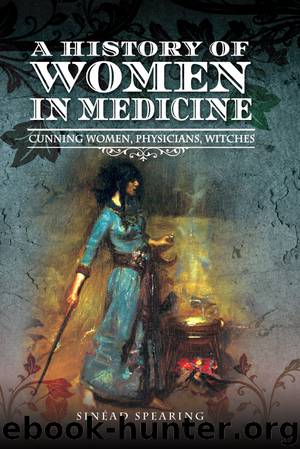A History of Women in Medicine by Spearing Sinead;

Author:Spearing, Sinead;
Language: eng
Format: epub
Tags: Gender studies: women
ISBN: 9781526714312
Publisher: Casemate Publishers & Book Distributors, LLC
Published: 2019-01-29T16:00:00+00:00
Chapter 9
The Problem of Truth
St Augustine of Canterbury (534-604 AD) carried on the work of his namesake and came to Hwicce country in the summer of 603 within the Gregorian mission to convert the Anglo-Saxon pagans and Celtic Christians to Roman Christianity. Bede reports that:
‘Augustine, with the help of King Ethelbert, drew together to confer with him the Bishops and Doctors of the next provinces of the Britons at a place which is called to this day, Augustine’s Ac (Oak), on the borders of the Hwiccas and the West Saxons.’
Roman Bishops met with British Bishops and ‘doctors’ at a great tree that became known as Augustine’s Oak, which may have stood in the Saxon villages of either Holy Oak or Mitre Oak on the Hwicce borderland. The story unfolds that the British Bishops refused to adopt the new Romanised version of Christianity and instead sought the counsel of a local hermit who suggested a second meeting, advising the British that should Augustine stand to greet them, then they should accept his offer and terms, but should Augustine fail to stand in greeting, then they should reject. Augustine did not stand and so the Hwicce rejected him.
By the time Augustine of Canterbury was standing under that oak tree on the edge of Hwicce territory, Augustine of Hippo had already written and published his four books on Christian Doctrine in the fourth to fifth centuries. The work, which included his new interpretation of Genesis and original sin, was designed to encourage and tutor his fellow clergy in the correct interpretation, teaching and defending of the Scriptures. Yet this work did not emerge in isolation.
Saint Augustine was in political collaboration with Theodosius the Great (347-395) to formally unite Constantine’s Nicene Christianity with the State of Rome. The Old Testament inclination towards a divinely sanctioned Kingship was politically attractive and provided templates of governmental power for law making and tax collection. This enabled a political structure under the auspices of a divinely associated council of clergy that was desirable for the Empire of Rome. As Will Durant explains in his 1994 book Caesar and Christ:
‘When Christianity conquered Rome: the ecclesiastical structure of the pagan church, the title and the vestments of the pontifex maximus, the worship of the Great Mother goddess and a multitude of comforting divinities, the sense of super sensible presences everywhere, the joy or solemnity of old festivals, and the pageantry of immemorial ceremony, passed like maternal blood into the new religion, and captive Rome conquered her conqueror. The reins and skills of government were handed down by a dying empire to a virile papacy.’
To this end, Theodosius, also inspired by Ambrose, Bishop of Milan, issued the Edict of Thessalonica in 380, which declared that Nicene Christianity, as forwarded by Constantine, was to be the only legitimate Imperial religion. By 393, he had banned pagan practices from state events and dissolved the status of the Roman Vestal Virgins. Theodosius’ agenda was the eradication of paganism and Augustine was to justify that eradication morally and theologically.
Download
This site does not store any files on its server. We only index and link to content provided by other sites. Please contact the content providers to delete copyright contents if any and email us, we'll remove relevant links or contents immediately.
| Civilization & Culture | Expeditions & Discoveries |
| Jewish | Maritime History & Piracy |
| Religious | Slavery & Emancipation |
| Women in History |
Cecilia; Or, Memoirs of an Heiress — Volume 1 by Fanny Burney(31374)
Cecilia; Or, Memoirs of an Heiress — Volume 3 by Fanny Burney(30969)
Cecilia; Or, Memoirs of an Heiress — Volume 2 by Fanny Burney(30923)
The Secret History by Donna Tartt(16717)
Sapiens: A Brief History of Humankind by Yuval Noah Harari(13126)
Leonardo da Vinci by Walter Isaacson(11953)
The Radium Girls by Kate Moore(10944)
Sapiens by Yuval Noah Harari(4579)
How Democracies Die by Steven Levitsky & Daniel Ziblatt(4447)
The Wind in My Hair by Masih Alinejad(4439)
Homo Deus: A Brief History of Tomorrow by Yuval Noah Harari(4305)
Endurance: Shackleton's Incredible Voyage by Alfred Lansing(3876)
The Silk Roads by Peter Frankopan(3811)
Man's Search for Meaning by Viktor Frankl(3672)
Millionaire: The Philanderer, Gambler, and Duelist Who Invented Modern Finance by Janet Gleeson(3599)
The Rape of Nanking by Iris Chang(3546)
Hitler in Los Angeles by Steven J. Ross(3462)
The Motorcycle Diaries by Ernesto Che Guevara(3364)
Joan of Arc by Mary Gordon(3282)
